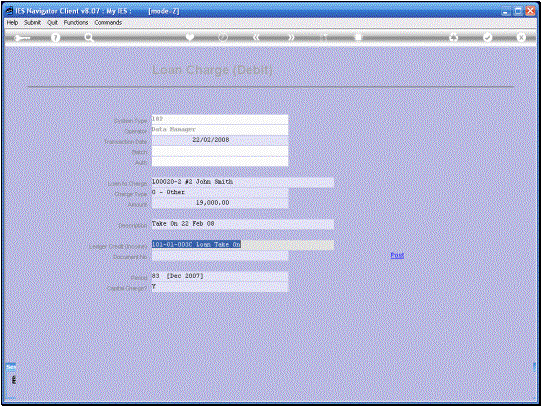Normally, when we Open a
New Loan, there is going to be a Cash Draw down at some stage, and that will
then become the Outstanding Balance on the Loan. In this Session we are
looking at how we do a Take-on for a Loan that already has a Balance. In other words we take over a Loan from
another System. |
So what we do in this
case is that we Open the Loan and then we perform a Loan Charge. Either to the Capital or
to the Capital and the Current Portions of the Loan. Note that on this New
Loan in this example, there is no Balance at the moment. In other words, the Loan
has been Opened but there is no Balance.
|
We
are not going to perform a Cash Draw down because the Loan is already in
existence and it has a Current Balance that we wish to Take-On. |
And
so we use a Loan Charge Option. |
The Transaction Date
that we use will be the Date of Taking Over the Loan Balance and the Loan
Balance as at this Transaction Date must include all Interest up to, and
including this date. Therefore we will
usually probably use an end of month date. In this example I am
using 22nd February. |
|
|
|
There
are different Charge Types that we may apply and in this case we would
usually use the Charge Type “Other”. |
|
|
|
|
|
|
Note
that we need a Ledger Contra for the Taking-On of the Balance and this will
usually be a Balance Sheet Account that we use as the Balancing of the
Taking-On of the Balance. |
|
|
|
|
The “Transaction Period”
is the Period in which we Record this Transaction. In this case I am using
Dec 07 (period 83). More appropriately it
probably should have been Feb 08. |
|
Now note that in this
case I am using Capital Charge as “Yes”. In other words the Full
Balance of 19.000 is going to be recorded against the Capital of the Loan. Now what if we have this
Loan Balance of 19,000, but 500 is actually an Installment that is Overdue,
i.e. Current. In that case we would have charged 18,500 against Capital and
then we would do another Transaction where we say Capital Charge is “No”. In other words the other
500 would then be posted against Current. In this case we are
saying there is nothing in Arrears at this point in time. So on the 22nd
February the Loan Balance of 19 000 actually represents the Capital Balance. |
|
|
|
|
|
|
|
|
|
|
If we now return to John
Smith’s Loan, we can see that we have a Loan Balance of 19,000 and all of it
is against Capital. So that is how we will
perform a Take-On transaction for a Loan Balance, where the Loan is already
in existence and has been for some time. |

































